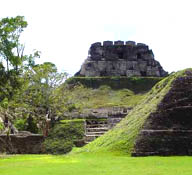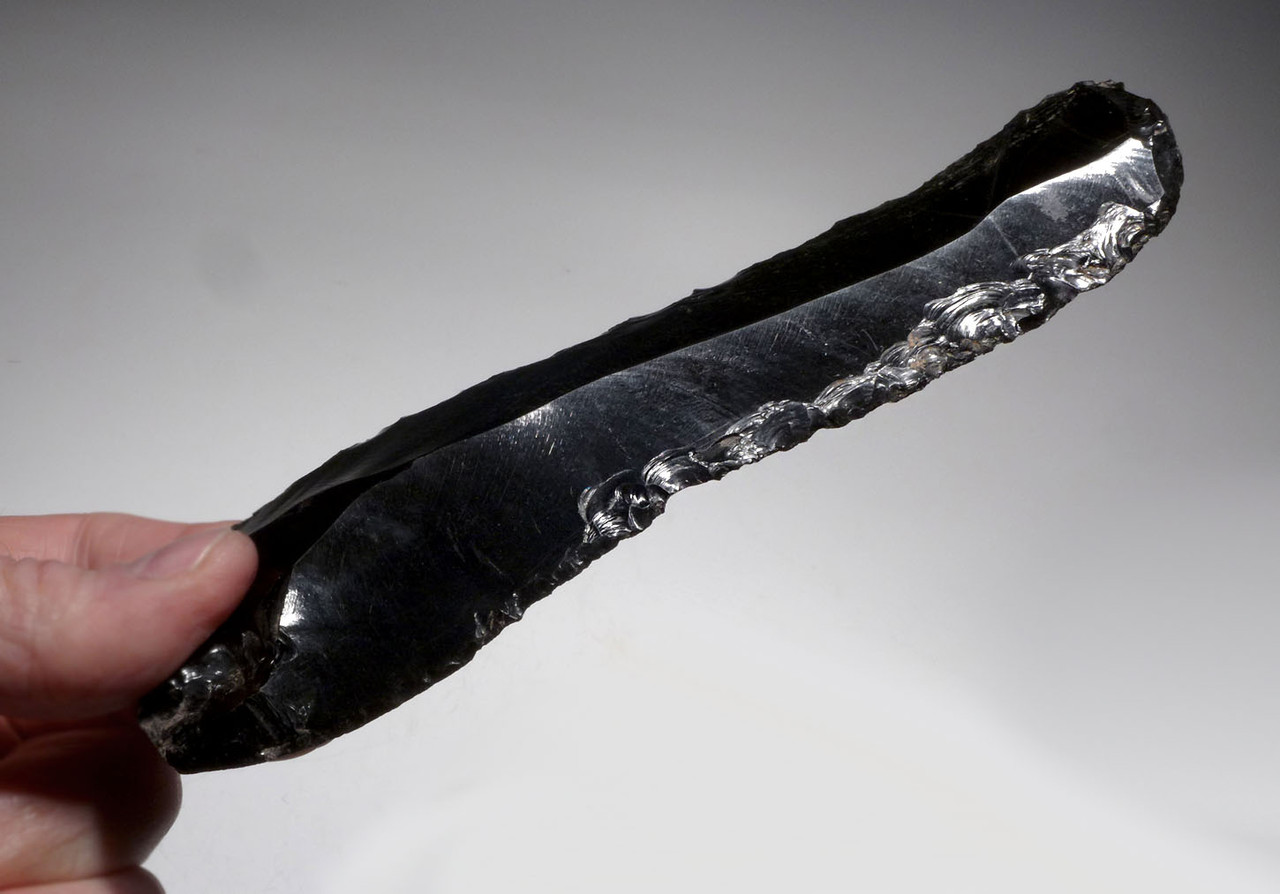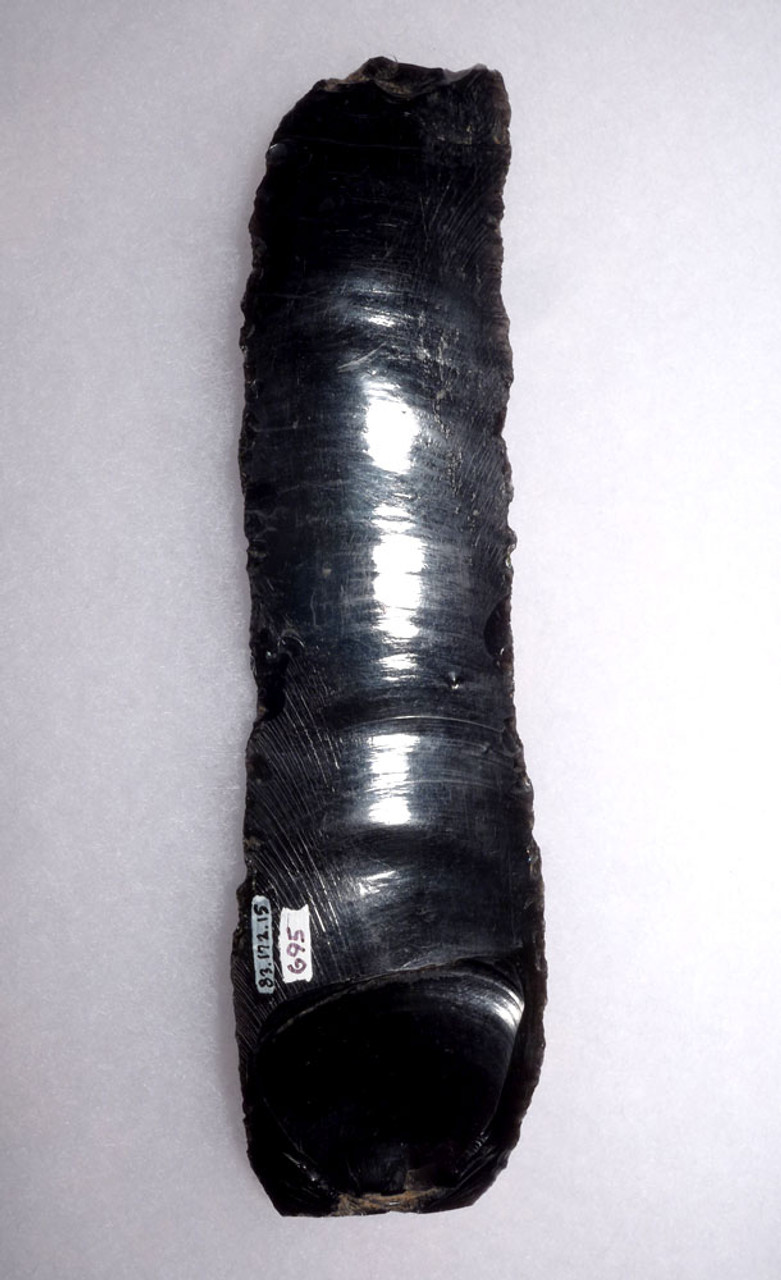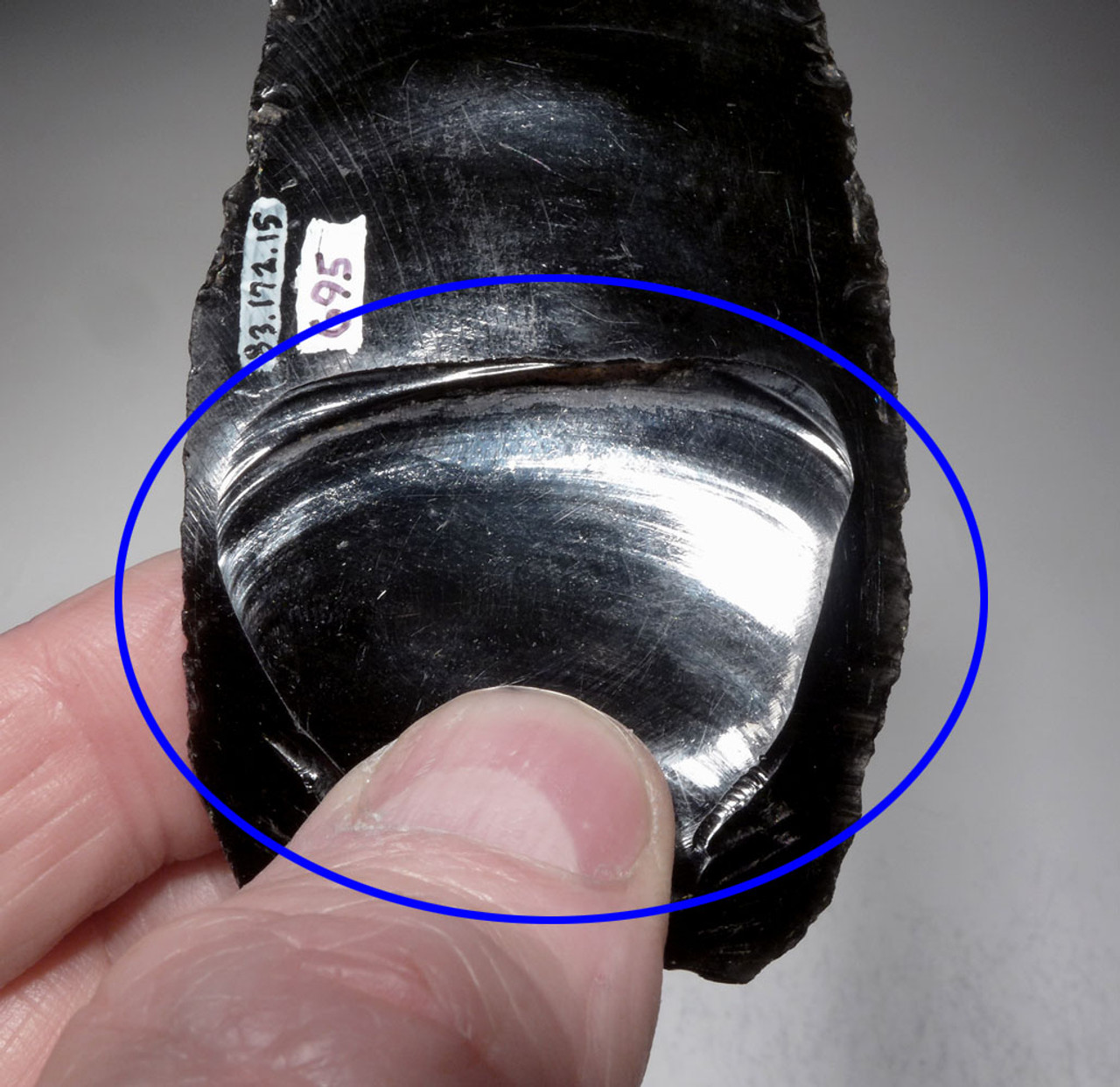Product Description
SEE MORE PRE-COLUMBIAN ARTIFACTS
Despite decades of dealing in the rarest ancient weapons, there have been some pieces that hypnotize us with their presence and impressiveness and this is certainly one of those times! Made on an enormous single struck obsidian blade that was extensively used, reused, and re-sharpened, this MASSIVE ancient Mayan Pre-Columbian UNIFACIAL PRISMATIC BLADE KNIFE is the largest of its kind we have ever handled! A blade this size is way beyond the ordinary size of typical prismatic blades that normally measure a fraction of this monster knife! It is not only large but made on a very thick struck blade. The cutting edges show considerable resharpening. A depression was flaked on the underside of the proximal end for a thumb to fit into the blade to aid in holding it. It is difficult to say why such a large blade was used. Considering the extensive human sacrifice the Maya engaged in, it is likely a blade of this size and robustness was used in the various gruesome tasks of human sacrifice.
Sacrifice by decapitation is depicted in Classic period Maya art, and sometimes took place after the victim was tortured, being variously beaten, scalped, burnt or disemboweled. Heart extractions and sacrifice have been viewed as a “supreme religious expression among the ancient Maya. Depending upon the exact ritual, sometimes the attendant priests would throw the corpse down the pyramid steps to the courtyard below, where it would be skinned by assistant priests, except for the hands and feet. The priest would then remove his ritual attire and dress in the skin of the sacrificial victim before performing a ritual dance that symbolized the rebirth of life. If it was a notably courageous warrior who had been sacrificed, then the corpse would be cut into portions and parts would be eaten by attending warriors and other bystanders. The hands and feet were given to the main priest who, if they had belonged to a war captive, wore the bones as a trophy. Archaeological investigations indicate that heart sacrifice was practiced as early as the Classic period.
From the famous Dr. Medina Pre-Columbian collection of which documentation will be provided to the buyer.
As irrefutable evidence of this blade knife's authenticity and completely unaltered, original state, the entire surface features original sediment and minerals impacted deep in all the flake scars and micro-crevices of the obsidian. Two original collection labels are left intact on the underside of the blade.
This is the first time in our 24 year career we have encountered a Pre-Columbian obsidian blade of this magnitude. As such, an unusual and unique weapon of such enormous proportions would have doubled as a display of status and rank. It most likely would have been owned and carried by a ruling member of Maya society. It could have also functioned as a public display weapon used by a Mayan high priest in human ritual sacrifice.
HISTORY
 Of all the ancient cultures of the Americas, no civilization has held more intrigue and secrets for so long as that of the Mayans. In 1960, their language code of glyphs was finally deciphered and forever changed our view of what we initially thought was a peaceful and harmonious society. On the contrary, the Mayan Culture of the latter years was bathed in the blood of vicious warfare and astounding levels of human sacrifice. Their technology was so advanced it is no wonder many believe they received intelligence from extra-terrestrials. Despite our recent discoveries of Mayan mathematics, astronomy and calendar technology, the Mayans still leave us with many mysteries. Their love of war caused them to manufacture spectacular weapons with inherent beauty and artistry. Their ceramics depict a fascinating culture of status, sacrifice and deep religious devotion to a number of strange gods.
Of all the ancient cultures of the Americas, no civilization has held more intrigue and secrets for so long as that of the Mayans. In 1960, their language code of glyphs was finally deciphered and forever changed our view of what we initially thought was a peaceful and harmonious society. On the contrary, the Mayan Culture of the latter years was bathed in the blood of vicious warfare and astounding levels of human sacrifice. Their technology was so advanced it is no wonder many believe they received intelligence from extra-terrestrials. Despite our recent discoveries of Mayan mathematics, astronomy and calendar technology, the Mayans still leave us with many mysteries. Their love of war caused them to manufacture spectacular weapons with inherent beauty and artistry. Their ceramics depict a fascinating culture of status, sacrifice and deep religious devotion to a number of strange gods.
Archaeologists divide the Mayan Culture into different periods - LATE PRE-CLASSIC / PROTO-CLASSIC (300 BC - 300 AD), EARLY CLASSIC (300 AD - 600 AD), LATE CLASSIC (600 AD - 830 AD), TERMINAL CLASSIC (830 AD - 950 AD). The earliest days of the Maya date back to 2000 BC when small farming villages first appeared in the highlands and Pacific coastline of Guatemala. Crops such as corn, squash and beans made up the staple of their diet and are believed to have been brought from previous migration through Mexico. The Maya pottery styles were unique to the early Maya settlements, though. By 1000 BC, villages sprang up in the lowland regions. The Maya lived in the same locations for centuries and in a continuous state of architectural improvement and expansion leading up to the magnificent 'super-cities' we associate with them today. By 300 AD. full-scale cities were being built with stone featuring massive plazas, temples and pyramids reaching 20 stories high.
It is no wonder that some believe that extra-terrestrial beings brought their knowledge to the Maya. By 300 AD, the first inscriptions suddenly appeared in Maya sites. These early inscriptions were so beautiful it was as if the gods had delivered it to the Mayan themselves! Forward to 600 years later and the inscriptions cease. The first comprehensive writing system in Pre-Columbian America was invented by the Maya. Among the mysteries of the Maya are their amazing understanding of astronomy along with the development of an accurate calendar and mathematical system. Their number system was based on units of 20 and included a concept of 'zero'.
The skills of the Mayan craft are exemplified in their stone and wood carvings, flaked stone objects, pottery and personal adornment. Much of their art centers around their devotion to a religion that is both fascinating and gory. Blood-letting rituals were the norm and many acts of war were motivated by the capture of vast numbers of their enemies for ritual human sacrifice that would run for days on end, forming lakes of blood and fat at the bases of their stone pyramids that defy architectural explanation.
Our understanding of the fascinating MAYAN CULTURE was completely wrong and misinterpreted until as recent as the 1960, when major achievements were made in the deciphering of their glyph language. Elaborately designed ceremonial cities lacking any obvious defenses initially led us to believe that the Mayans were a peaceful theocracy living in ideal harmony with their environment and each other. We could not have been further from the truth. Lowland city-states lived in constant warfare with one another and the thirst of their gods for human blood and sacrifice seemed impossible to satiate.
Perhaps a lesson for us today, recent scientific analysis of the demise of the highly advanced Mayan civilization now answers the biggest mystery of all - "What ever happened to the ancient Mayans?". Long-term high population density (500 people per square mile - the highest in the world at the time) of unbelievable proportions put a strain on their agricultural system that was impossible to sustain. The effects of nutritional deficiencies are evident in bone and tooth analysis on graves dating to the Late Classic Period. It is most probable that starvation put unbearable sociopolitical stress on the society to either kill each other for food or die of hunger necessitated by the technological advancement of warfare and its escalation.
References:
- Fiedel, Stuart J., Prehistory of the Americas, 1992 - Freeman and Company, Early Man in America, 1973
- Hirth Kenneth, Obsidian Craft Production in Ancient Central Mexico, 2006
- Muser, Curt, Facts and Artifacts of Ancient Middle America, 1978
- Phillips, Charles, The Complete Illustrated History of the Aztec and Maya, 2008
 US DOLLAR
US DOLLAR
 EURO
EURO
 AUSTRALIAN DOLLAR
AUSTRALIAN DOLLAR
 CANADIAN DOLLAR
CANADIAN DOLLAR
 POUND STERLING
POUND STERLING






















